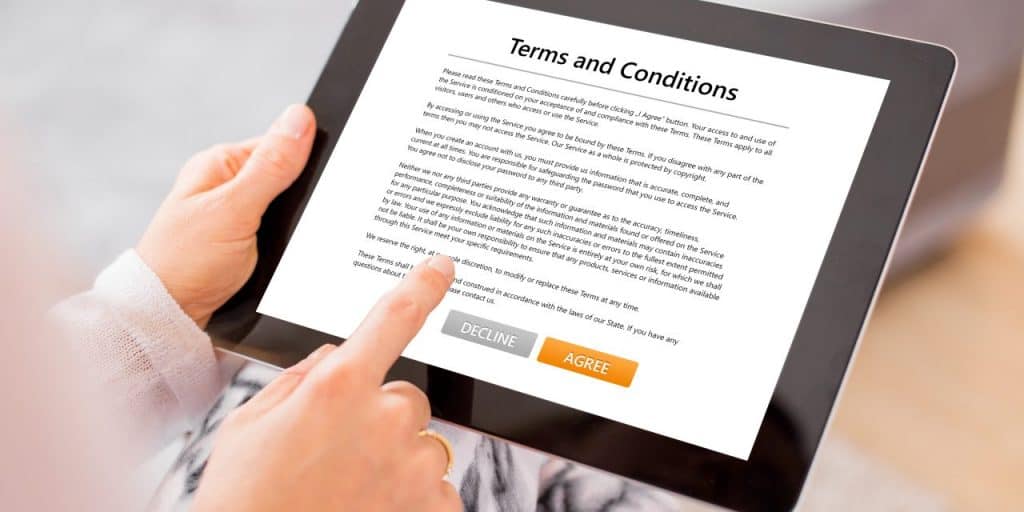Having an attractive and functional blog is crucial for any business or individual trying to succeed in today’s day and age. A good blog usually has a few pages that are considered mandatory. A landing page, about page, contact page, FAQ page, and a few more, depending on the type of blog and for which purpose it was developed.
So, you’ve built a blog that has all these pages, and you might be thinking your work is done, and your blog can go live. Well, you’re wrong. Like a lot of people, you forget a few essential pages, the legal pages.
Disclaimers
Disclaimers are used to make points about liability, risks, copyrights, and other important topics. They are the text used to limit the scope of something that is offered, whether it be a product, service, information, or something else.
Disclaimers are a necessity for all websites, and they should be made custom for each site. Applying general disclaimers to your website isn’t the wisest idea since they aren’t specific to the service or product you are offering.
There are a few types of disclaimers:
- Fair use disclaimers. These disclaimers protect you from being accused of copyright infringement.
- Errors and emissions disclaimers. In case the information on your site is inaccurate, you can’t be held accountable for any damages caused by the misleading information.
- Email disclaimers. They assure that the communication done via email is confidential, and only intended for the recipient.
- Investment disclaimers. Used by any site that provides investment advice, and states that the person publishing the advice doesn’t possess any insider information, is not a broker, investment advisor.
- Expressed views disclaimer. Indented for sites where people express their personal opinions. This disclaimer says that all the expressed views, thoughts, and opinions belong solely to the author.
- No responsibility disclaimer. A disclaimer removing any responsibility from you, in the case that using your app or website causes any damages. It is usually used as an end-user license agreement for software.
- Past performance disclaimer. Often used by sites for the investment and financial market, or other sites with unpredictable results. This disclaimer says that future results aren’t guaranteed by past performance.
- Use at your own risk disclaimers. For sites that offer recipes, tutorials, advice, sell medications or share any information that people might use and rely on. It removes any legal responsibility in case the information provided doesn’t work out correctly.
Depending on the country and the type of website you have, you required by law to have disclaimers as a part of your site. For example, sites used to advertise and sell weight-loss products, can’t use deceptive before and after pictures as advertisements or make any false statements that would support the deceptive images. Saying that it’s possible to lose 10kg within a week simply by using the weight-loss product would be very misleading.
Every statement made about the product needs to be objective and backed up by scientific evidence or say that the example shown represents an unusual result. Placing false statements on your website without any disclaimers can lead to serious legal issues, hefty fines, and give your company a bad name.
Sites that offer information and advice regarding health-related issues should clearly state that the content they are displaying is should only be used for educational purposes, not as any sort of diagnosis. When doing that, do it reasonably. A lot of sites of this sort, like, for instance, WebMD, in order not to get sued, emphasize the worst possible outcome of a symptom, instilling fear and worry in people for no reason.
While creating and putting disclaimers on your site, there are a few things you should keep in mind.
The disclaimer needs to be placed in a visible/noticeable place. If for some reason, you need to use the disclaimer in a court setting in your defense, a judge won’t see a disclaimer that was “buried” somewhere in the website as fair or as compelling evidence rather as something you wanted to hide.
Remember, a disclaimer won’t protect you from everything. If you are committing a crime or creating an unsafe environment for the consumers, no disclaimer will help you. Everything you put in the disclaimer must be lawful and reasonable.
Terms and conditions
Terms and conditions represent somewhat of an agreement between you and the visitor of your website, or user of a service you are providing, which states that the user is agreeing to a set of rules and conditions you have set for someone wanting to use your product/service.
Before, the terms and conditions used to be displayed on a separate page that you could reach by following a link from the initial page. This approach wasn’t regarded as transparent in the eyes of the law.
An approach that is the standard nowadays and is seen as fair and transparent is the so-called “checkbox” approach, which I’m sure most of us are familiar with. It asks the user to agree to a statement saying that they have read and are agreeing to the presented terms and conditions. In the case that the user clicks the checkbox but doesn’t actually agree with the terms and conditions, or hasn’t even read them, it is entirely their fault.
Some businesses go as far as putting a disclaimer near the checkbox in order to avoid having any legal responsibility. This should be done with caution. From a legal perspective, this is great, but from a business perspective, not so much. It might give the customer a feeling that there is a lack of credibility in what you are offering, or that there might be something wrong with your product or service.
So, when thinking of the format of your terms and conditions, make it straightforward, and of course, lawful in order legally protect yourself, but don’t make it too intimidating in order to avoid scaring off your customers or making them doubt your product or service.
Privacy policy
Every visitor of a website leaves behind a trail of information, like their location, IP address, name and email, purchase details, credit card info, and more. A privacy policy is a way to let your consumer know what information you are collecting from them, for which purpose, and who else has access to that information.
Any website that uses cookies and/or collects any information needs to have a privacy policy in place. In most countries, it is required by law. For example, the EU has a law in place called the General Data Protection Regulation, which requires anyone who markets or sells to customers in an EU country to strictly abide by it.
Besides the legal requirement to have a privacy policy, having one shows the consumers that you are taking steps to protect their information, and gives your business a more official look.
You can create your privacy policy by using a free template, or by hiring a lawyer in order to help you create a custom one for your website if you see that as necessary.
The privacy policy can always be updated, but make sure that before making any updates to the privacy policy, you have stated in the previous version that you have the right to do so.
Conclusion
Many people still view these three things like an optional part of a website, or they entirely forget about them. Doing that today, when personal data is viewed as one of the world’s most valuable assets, is unacceptable. In order to have a successful, interactive, and appealing blog, you will most likely need your customers’ data. To collect that data, you will need to gain the trust of your consumers, and you can do that by having clear disclaimers, terms and conditions, and privacy policies put in place.
Those three things will also make it easier for you to be sure that you are following the law and avoiding any unwanted legal issues. They will help you in protecting your intellectual property and the intellectual property of the people who’s content you might be putting on display. By using disclaimers, you can openly disclose any affiliate relationships or paid promotions, which, if not disclosed can lead to serious legal implications in some places.
And above everything, these three things will help you protect your and your users’ privacy, which we all know is a growing concern for everyone from the consumers and businesses to the highest government officials.


